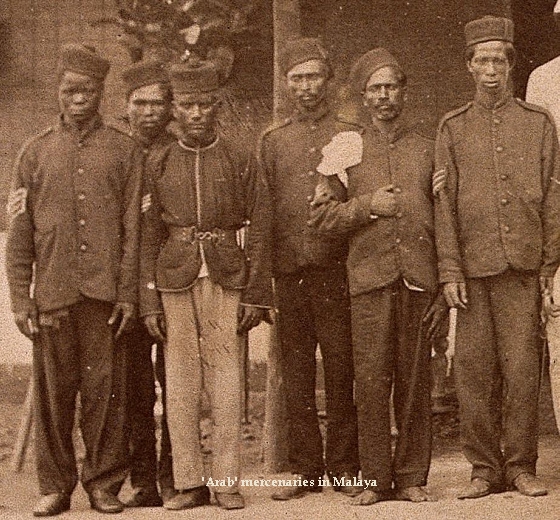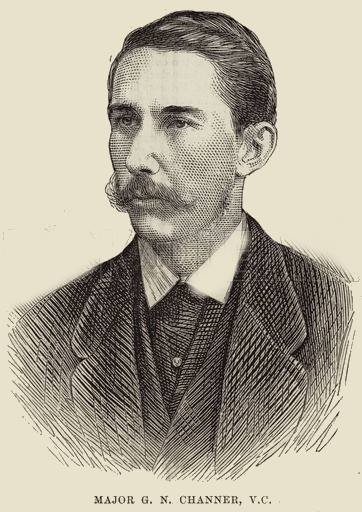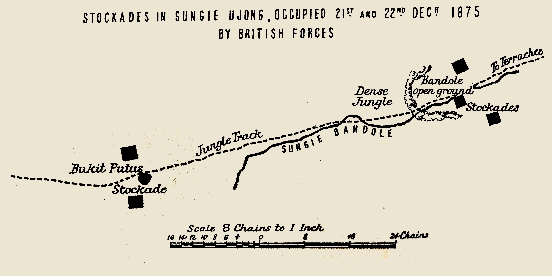

|
The Battle of Bukit
Putus
 After the battle of Paroi, the British advance halted as it waited for its Gurkha reinforcements to arrive, which they did three days later on December 10th, 1875. The Malays had by now prepared heavily fortified defensive positions on the Bukit Putus Pass. The British decided to combine a frontal attack on Bukit Putus with a flanking movement behind the hills north of the pass. Murray offered to guide a composite force of Gurkhas and sailors over the Langkap pass which would get round into the Terachi valley by way of Jelebu and threaten the Bukit Putus position from the rear. The main force of Gurkhas, 10th Regiment of Foot and Arabs would mount the frontal assault.  The Malays had built three stockades on the Bukit Putus Pass. One in the middle of the pass commanding the path and was situated on a small hill about 25 feet high with the pass on one side and a corresponding hollow, not cleared of jungle, on the other. The other two stockades were situated at a greater height, about 35 feet, on the sides of the hills at about 30 yards on each side of it. A reconnaissance patrol consisting of 25 men of the 1st Gurkhas led by Channer proceeded up the Pass and they soon saw smoke and fires, and working cautiously through the jungle, encountered one of the Malay log stockades. A palisade enclosed it and the ground was covered with ranjaus (crows feet of sharp bamboos). Channer had come on one of the upper stockades on the right flank of the Malay position.  The Malays had kept no look-outs and most
of them appeared to be cooking a communal meal at the
time. Channer seized the opportunity and was the first to
jump into the stockade, followed by two Gurkhas. He found
it occupied by 25 to 30 men. The first man Channer shot
dead with his revolver, and the two Gurkhas each shot a
Malay. They were soon followed by the rest of their party
and the Malays in that stockade fled. Channer was then
engaged in an exchange of fire with the Malays in the two
other stockades, 80 yards and 160 yards away. Some of the
Gurkhas had attempted to advance up the hill as well but
had to retreat due to being fired upon by their own Arab
allies by mistake. But, as Channer was on higher ground
than the central stockade, which was the nearer, he was in
a good position. After half an hour's firing the Malays
withdrew. The Bukit Putus position had been taken. The
first Victoria Cross ever awarded for action in Malaya was
to Captain George Nicholas Channer for his actions in
capturing the Malay stockade at the Bukit Putus Pass. The Malays had kept no look-outs and most
of them appeared to be cooking a communal meal at the
time. Channer seized the opportunity and was the first to
jump into the stockade, followed by two Gurkhas. He found
it occupied by 25 to 30 men. The first man Channer shot
dead with his revolver, and the two Gurkhas each shot a
Malay. They were soon followed by the rest of their party
and the Malays in that stockade fled. Channer was then
engaged in an exchange of fire with the Malays in the two
other stockades, 80 yards and 160 yards away. Some of the
Gurkhas had attempted to advance up the hill as well but
had to retreat due to being fired upon by their own Arab
allies by mistake. But, as Channer was on higher ground
than the central stockade, which was the nearer, he was in
a good position. After half an hour's firing the Malays
withdrew. The Bukit Putus position had been taken. The
first Victoria Cross ever awarded for action in Malaya was
to Captain George Nicholas Channer for his actions in
capturing the Malay stockade at the Bukit Putus Pass.  The Malays might yet have stood and fought again on some other position in the Terachi valley. But the sudden appearance of Murray's column emerging from the Langkap pass in their rear demoralised them completely. The Malay forces retreated and dispersed into the interior. Expecting the worst from the invading British forces, the inhabitants of the Terachi valley fled as well, abandoning their villages and leaving them empty and desolate. Two Malay stockades at Ulu Bandol were found deserted and the British burned these to the ground. All along the Terachi valley, houses, farms and whole villages were left empty and Fontaine's Arabs took great delight in burning these to the ground and looting everything they could find. The Feb 17th 1876 issue of the Pall Mall Gazette in London described how the Arabs were "enjoying the burning and pillaging, and evidently were quite in their element" and this raised quite a great deal of criticism in the House of Lords as to the justification and conduct of the war. The British forces converged upon Yamtuan Antah's stronghold in Seri Menanti and burned his palace, the Istana Pulih, to the ground. Years later, the Sungei Ujong War Memorial was erected in Malacca. The obelisk was built to honour the British, Gurkha and Arab troops who died in the Sungei Ujong campaign. Murray is also buried in Malacca, at the Bukit Serindit Cemetery. Details of the battle of Bukit Putus can be found in 'Professional papers of the Corps of Royal Engineers' (Chatham Royal Engineers 1877) which is available for download at The Internet Archive.
About the WebmasterWrite to the WebMaster: sabrizain@malaya.org.uk
|
|---|